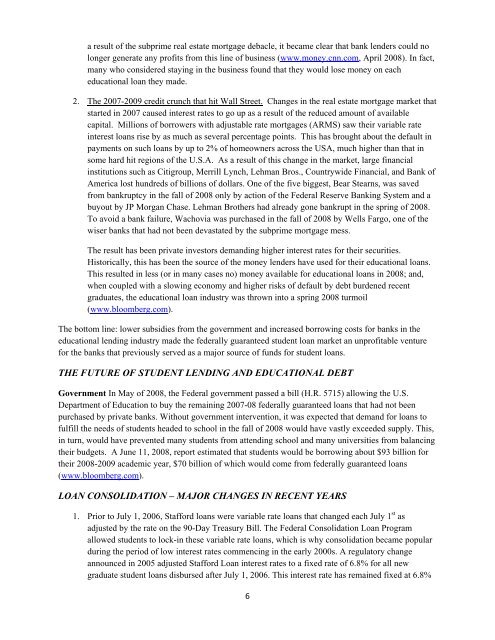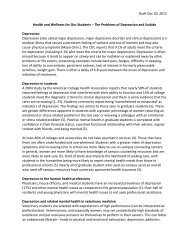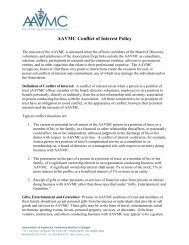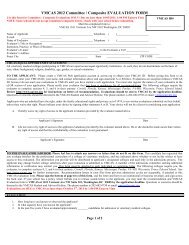Student Loans 101: Taming The Educational Loan Monster
Student Loans 101: Taming The Educational Loan Monster
Student Loans 101: Taming The Educational Loan Monster
You also want an ePaper? Increase the reach of your titles
YUMPU automatically turns print PDFs into web optimized ePapers that Google loves.
a result of the subprime real estate mortgage debacle, it became clear that bank lenders could nolonger generate any profits from this line of business (www.money.cnn.com, April 2008). In fact,many who considered staying in the business found that they would lose money on eacheducational loan they made.2. <strong>The</strong> 2007-2009 credit crunch that hit Wall Street. Changes in the real estate mortgage market thatstarted in 2007 caused interest rates to go up as a result of the reduced amount of availablecapital. Millions of borrowers with adjustable rate mortgages (ARMS) saw their variable rateinterest loans rise by as much as several percentage points. This has brought about the default inpayments on such loans by up to 2% of homeowners across the USA, much higher than that insome hard hit regions of the U.S.A. As a result of this change in the market, large financialinstitutions such as Citigroup, Merrill Lynch, Lehman Bros., Countrywide Financial, and Bank ofAmerica lost hundreds of billions of dollars. One of the five biggest, Bear Stearns, was savedfrom bankruptcy in the fall of 2008 only by action of the Federal Reserve Banking System and abuyout by JP Morgan Chase. Lehman Brothers had already gone bankrupt in the spring of 2008.To avoid a bank failure, Wachovia was purchased in the fall of 2008 by Wells Fargo, one of thewiser banks that had not been devastated by the subprime mortgage mess.<strong>The</strong> result has been private investors demanding higher interest rates for their securities.Historically, this has been the source of the money lenders have used for their educational loans.This resulted in less (or in many cases no) money available for educational loans in 2008; and,when coupled with a slowing economy and higher risks of default by debt burdened recentgraduates, the educational loan industry was thrown into a spring 2008 turmoil(www.bloomberg.com).<strong>The</strong> bottom line: lower subsidies from the government and increased borrowing costs for banks in theeducational lending industry made the federally guaranteed student loan market an unprofitable venturefor the banks that previously served as a major source of funds for student loans.THE FUTURE OF STUDENT LENDING AND EDUCATIONAL DEBTGovernment In May of 2008, the Federal government passed a bill (H.R. 5715) allowing the U.S.Department of Education to buy the remaining 2007-08 federally guaranteed loans that had not beenpurchased by private banks. Without government intervention, it was expected that demand for loans tofulfill the needs of students headed to school in the fall of 2008 would have vastly exceeded supply. This,in turn, would have prevented many students from attending school and many universities from balancingtheir budgets. A June 11, 2008, report estimated that students would be borrowing about $93 billion fortheir 2008-2009 academic year, $70 billion of which would come from federally guaranteed loans(www.bloomberg.com).LOAN CONSOLIDATION – MAJOR CHANGES IN RECENT YEARS1. Prior to July 1, 2006, Stafford loans were variable rate loans that changed each July 1 st asadjusted by the rate on the 90-Day Treasury Bill. <strong>The</strong> Federal Consolidation <strong>Loan</strong> Programallowed students to lock-in these variable rate loans, which is why consolidation became popularduring the period of low interest rates commencing in the early 2000s. A regulatory changeannounced in 2005 adjusted Stafford <strong>Loan</strong> interest rates to a fixed rate of 6.8% for all newgraduate student loans disbursed after July 1, 2006. This interest rate has remained fixed at 6.8%6










